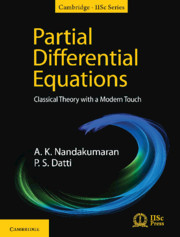Book contents
- Frontmatter
- Dedication
- Contents
- List of Illustrations
- Preface
- Acknowledgments
- Notations
- Chapter 1 Introduction
- Chapter 2 Preliminaries
- Chapter 3 First-Order Partial Differential Equations: Method of Characteristics
- Chapter 4 Hamilton–Jacobi Equation
- Chapter 5 Conservation Laws
- Chapter 6 Classification of Second-Order Equations
- Chapter 7 Laplace and Poisson Equations
- Chapter 8 Heat Equation
- Chapter 9 One-Dimensional Wave Equation
- Chapter 10 Wave Equation in Higher Dimensions
- Chapter 11 Cauchy–Kovalevsky Theorem and Its Generalization
- Chapter 12 A Peep into Weak Derivatives, Sobolev Spaces and Weak Formulation
- References
- Index
Chapter 12 - A Peep into Weak Derivatives, Sobolev Spaces and Weak Formulation
Published online by Cambridge University Press: 20 May 2020
- Frontmatter
- Dedication
- Contents
- List of Illustrations
- Preface
- Acknowledgments
- Notations
- Chapter 1 Introduction
- Chapter 2 Preliminaries
- Chapter 3 First-Order Partial Differential Equations: Method of Characteristics
- Chapter 4 Hamilton–Jacobi Equation
- Chapter 5 Conservation Laws
- Chapter 6 Classification of Second-Order Equations
- Chapter 7 Laplace and Poisson Equations
- Chapter 8 Heat Equation
- Chapter 9 One-Dimensional Wave Equation
- Chapter 10 Wave Equation in Higher Dimensions
- Chapter 11 Cauchy–Kovalevsky Theorem and Its Generalization
- Chapter 12 A Peep into Weak Derivatives, Sobolev Spaces and Weak Formulation
- References
- Index
Summary
Throughout the earlier chapters, we have seen the necessity of definingsolutions in a sense other than the well-known classical solutions. In otherwords, we need to go out of the realm of smooth solutions to capture thephysically relevant solutions. In fact, we have established the existence ofcertain types of weak solutions in the context of Hamilton–Jacobiequations and Conservation Laws. Further, we have also indicated in Chapter7, the existence of an integral formulation corresponding to a minimizationproblem given by the Dirichlet functional. Generically, we term suchsolutions as weak solutions. In fact, there are differentconcepts of weak solutions that have been developed in the last 100 years orso; like distribution solutions, transposition solutions, entropysolutions, viscosity solutions, and so on. Among them thenotion of weak solutions in the sense of distributions, weak formulation andSobolev spaces took centre stage in the first half of the last century, andsubsequently changed the scenario of the study of partial differentialequations. As remarked earlier, the necessity of introducing the aboveconcepts was evident from the study of Dirichlet functionals from the secondhalf of the eighteenth century and early part of the nineteenth century.Sobolev was quite successful in defining appropriate function spaces (theso-called Sobolev spaces) using generalized functions. A stable foundationwas given later by the introduction of distributions by L.Schwartz in the 1940s (see Brezis, 2011; Kesavan, 1989; Schwartz, 1966).This new development was not only useful in the study of PDEs, but it couldalso rigorously establish the notions of Dirac 𝛿function, its derivatives and the symbolic calculus developed by thephysicists including Paul Dirac.
Without going much into the details, we would like to introduce here thenotion of weak derivative of functions that are, otherwise,not classically differentiable and certain associated spaces, which arerequired to study solutions of weak formulation. In the process, we see someideas about the modern theory of PDEs.
WEAK DERIVATIVES
Quite often, given a function f, the valuef(x) represents a physical quantity atthe point x, say, temperature at x. Pointbeing a mathematical concept, physically (or experimentally), it cannotdetermine any physical quantity exactly at a point, rather we can onlyobtain the average quantity in a neighborhood of the point.
- Type
- Chapter
- Information
- Partial Differential EquationsClassical Theory with a Modern Touch, pp. 334 - 347Publisher: Cambridge University PressPrint publication year: 2020



